Energy Carbon Emission Reduction Based on Spatiotemporal Heterogeneity: A County-Level Empirical Analysis in Guangdong, Fujian, and Zhejiang
Abstract
1. Introduction
2. Materials and Methods
2.1. Study Area and Data Sources
2.2. Methods
2.2.1. Framework
2.2.2. ECEs Estimates Based on NTL Remote Sensing Inversion
2.2.3. Trend Analysis
2.2.4. STWR
2.2.5. Steps of Path Analysis
- (1)
- Defining paths and path occurrences. In this study, we regarded the shifts in dominant factors as paths, including their types and the positive and negative impacts (indicated by +/−). Different counties may experience the same path (shift in the dominant factor) at different times, and a single occurrence is a path occurrence corresponding to the path.
- (2)
- Path filtering rules. To reduce noise and enhance the robustness of the learning path, some rules need to be formulated, such as eliminating paths with fewer occurrences. In this study, we removed paths with less than or equal to 5% of the total path occurrences (the minimum number of occurrences is 4).
- (3)
- Link to local change in ECEs. Each path occurrence can be linked to a specific county’s ECEs change ().
- (4)
- Path sorting and extraction. For each path, we can average all the linked ECEs changes of their path occurrences. Then, we can extract the best path in different counties by sorting or other calculation methods.
3. Results
3.1. Verification of the County-Level ECEs Estimates
3.2. Analysis of ECEs Trends
3.3. Spatiotemporal Heterogeneity
3.3.1. Multicollinearity Diagnostics
3.3.2. Impacts of Population (P)
3.3.3. Impacts of Impervious Surfaces (I)
3.3.4. Impacts of Manufacturing (M)
3.3.5. Impacts of Services (S)
3.4. Path Analysis
4. Discussion
- (1)
- It supports the dynamic path analysis of local carbon reduction. Most path analyses for reducing carbon emissions are based on global models, meaning that they ignore the local variations in relationships in space and time. The proposed framework incorporated spatiotemporal heterogeneity using the STWR model and established a channel for path learning, i.e., learning from binding the shifts in dominant factors and the change in the amount of carbon emissions. Therefore, it provides sophisticated, map-based visual support for forming regionally and temporally differentiated carbon reduction paths.
- (2)
- The learned path from the framework is a strong indicative reference because it is tied to carbon emissions; it is therefore able to indicate the amount of increase or decrease in carbon emissions. The local dominant factor is detectable, so the local optimal path and expected carbon emission changes under different development periods (modes) can be predicted and mapped. Supposing that a county’s current dominant factor is “M+”, if the current ECEs are during the active period, the “M+ → S−” path would be preferred because it reduced about 7.747 × 105 tons of ECEs in the past. During the stable period, the path “M+ → P+” would be better because it increased the ECEs the least, by about 1.112 × 105 tons. The practical guiding significance of these two paths is also very strong. For fast-growing regions, the former path can be pursued to reduce carbon emissions and achieve high-quality growth, while, for slower-growing regions, the latter path may be more suitable to control carbon emission growth. Figure 9c,f show the optimal paths for reducing ECEs at the county level for the active and stable periods, respectively.
- (3)
- Each path learned from the framework can be tracked for its corresponding shift occurrences, including occurrence times and locations. This feature can provide references for regions with similar development patterns and is conducive to analyzing regional abnormal carbon emissions. Many paths detected in our empirical analysis are highly interpretable. Figure 10 shows three paths, “S+ → I+”, “M+ → S−”, and “S+ → P+”, and all their corresponding counties and related amounts of ECEs. Counties with the same path show clustering characteristics in space. “S+ → I+” occurred in four counties: Dongyang, Yiwu, Lanxi, and Pujiang. The reductions made by this path are significant and relatively uniform. This result may be related to the effectiveness of these counties in actively promoting the construction of smart cities, which is consistent with [59]. “M+ → S−” occurred in four counties: Xiashan, Mazhang, Chikan, and Potou. The average proportion of these counties’ secondary and tertiary industries (M and S) changed from 50.4% and 43.6% in 2015 to 47.95% and 46.83% in 2018. The service industry (S), which has low energy consumption and high added value, has gradually increased, reducing ECEs. “S+ → P+” occurred in five counties: Puning, Lufeng, Chengqu, Haifeng, and Zijin. The increased amount of ECEs may be caused by the loss of the high-tech population and the improvement in the service quality of S (the tertiary industry) in these counties. That is, these counties may have an insufficient proportion of people engaged in high-tech (low-carbon emission) industries, while a large proportion of people are engaged in low-end industries with high carbon emissions, which has led to a surge in ECEs. It is worth noting that although the overall change in the amounts of carbon emissions fluctuates around the average, some individual counties have large deviations. If more data are used, the number of occurrences of each path increases, making it more stable and reliable.
- (4)
- This study also supports a comparative analysis of the selected counties and of counties with similar conditions. As shown in Table 6, Enping and Xinxing counties are very close in terms of spatial location (Figure 1), ECEs, dominant factors, population, industrial structure, etc. Their ECEs values are both around 1.5 million tons, with a difference of less than 500,000 tons. Their populations are both around 470,000. Their proportions of secondary industry (manufacturing, M) are about 30%, less than their proportion of tertiary industry (service, S). Their dominant factors have shifted from P+ to I+. However, the conditions of Lufeng County are quite different from those of Enping and Xinxing. Its ECEs exceeded 3 million tons, with a change of more than 1 million tons. Its population doubled to 1.4 million. S was higher than M, and its dominant factor remained unchanged.
- (5)
- By conducting an empirical analysis, we can form “tailor-made” countermeasures for different regions. On the one hand, different counties should adopt different countermeasures. For counties with lower S values, such as Mazhang and Potou, “M+ → S−” is the most effective path (Figure 9b). For areas with higher S values, such as Dongyang and Yiwu, “S+ → I+” is the most effective path (Figure 9e). Therefore, for counties such as Mazhang and Potou, the development of tertiary industry (S) should be actively promoted in the future. In terms of tax incentives, reduction and exemption can be increased according to the progress of enterprise transformation; for Dongyang and Yiwu, the construction of smart cities could be accelerated, and the corresponding supporting infrastructure can be established. On the other hand, for the same county, different countermeasures should be taken according to different development stages (at different times). For example, for counties with low populations, such as Xiashan and Chikan, the path “M+ → S−” significantly reduced energy carbon emissions during the active period (Figure 9b), while, in the stable period, the path “S− → P+” (Figure 9e) effectively reduced energy carbon emissions. Therefore, during the active period, we can increase support for tertiary industry (S) and promote the transformation of secondary industry (M) to tertiary industry (S). During the stable period, we can strengthen talent policies, such as by providing housing subsidies and preferential treatment for children’s schooling, to attract high-tech talents.
- (1)
- Although the locally optimal path and its related amount of carbon emissions can be learned from our framework, the matter of how to guide the achievement of the optimal path remains unknown. Some optimal paths (i.e., shifts in dominant factors) learned from other regions may also face significant challenges when implemented locally. Therefore, further research is needed to more specifically guide regions to complete the transition to the optimal paths.
- (2)
- Due to some limitations in data availability, our empirical analysis only considered four factors (i.e., P, I, M, and S), but there may be many other factors that affect regional ECEs in the real world. Further study can consider more socio-economic factors, such as the import and export trade volume, scientific and technological research and development investment, the number of high-tech enterprises, etc. Moreover, a broader carbon reductions (not just ECEs) study should be considered.
- (3)
- The estimation of local ECEs based on NTL remote sensing image inversion may have different errors in space and time. The reasons for these errors may be multifaceted. Although the VANUI method used in this study can effectively reduce the saturation effect of NTL to a certain extent, for areas with large NDVI values, the VANUI will not increase the variability in NTL values in the region [44]. The NDVI data obtained by satellite remote sensing will also be affected by factors such as atmospheric interference and cloud cover, resulting in errors [60]. This, in turn, will affect the final ECEs estimation. Subsequent research may consider using a more scientific remote sensing image inversion model.
- (4)
- The adopted STWR model has the following main limitations, which may affect the reliability of the analysis results: (1) The model has only one (initial) spatial and one temporal bandwidth and does not support multi-scale analysis. (2) There is still room for improvement in the local spatiotemporal weight configuration and parameter optimization calibration process. (3) The model assumes a locally linear relationship, but the real-world situation may be non-linear and more complicated.
5. Conclusions
Author Contributions
Funding
Institutional Review Board Statement
Informed Consent Statement
Data Availability Statement
Conflicts of Interest
References
- Ledley, T.S.; Sundquist, E.T.; Schwartz, S.E.; Hall, D.K.; Fellows, J.D.; Killeen, T.L. Climate change and greenhouse gases. Eos Trans. Am. Geophys. Union 1999, 80, 453–458. [Google Scholar]
- Mora, C.; Spirandelli, D.; Franklin, E.C.; Lynham, J.; Kantar, M.B.; Miles, W.; Smith, C.Z.; Freel, K.; Moy, J.; Louis, L.V. Broad threat to humanity from cumulative climate hazards intensified by greenhouse gas emissions. Nat. Clim. Chang. 2018, 8, 1062–1071. [Google Scholar]
- Mitchell, J.F.; Lowe, J.; Wood, R.A.; Vellinga, M. Extreme events due to human-induced climate change. Philos. Trans. R. Soc. A Math. Phys. Eng. Sci. 2006, 364, 2117–2133. [Google Scholar]
- Gasparrini, A.; Guo, Y.; Sera, F.; Vicedo-Cabrera, A.M.; Huber, V.; Tong, S.; Coelho, M.d.S.Z.S.; Saldiva, P.H.N.; Lavigne, E.; Correa, P.M. Projections of temperature-related excess mortality under climate change scenarios. Lancet Planet. Health 2017, 1, e360–e367. [Google Scholar] [PubMed]
- Gillett, N.P.; Shiogama, H.; Funke, B.; Hegerl, G.; Knutti, R.; Matthes, K.; Santer, B.D.; Stone, D.; Tebaldi, C. The Detection and Attribution Model Intercomparison Project (DAMIP v1.0) contribution to CMIP6. Geosci. Model Dev. 2016, 9, 3685–3697. [Google Scholar]
- Li, X.; Lin, C.; Lin, M.; Jim, C.Y. Drivers, scenario prediction and policy simulation of the carbon emission system in Fujian Province (China). J. Clean. Prod. 2024, 434, 140375. [Google Scholar] [CrossRef]
- Yang, P.; Peng, S.; Benani, N.; Dong, L.; Li, X.; Liu, R.; Mao, G. An integrated evaluation on China’s provincial carbon peak and carbon neutrality. J. Clean. Prod. 2022, 377, 134497. [Google Scholar]
- Bai, Y.; Zhou, P.; Tian, L.; Meng, F. Desirable strategic petroleum reserves policies in response to supply uncertainty: A stochastic analysis. Appl. Energy 2016, 162, 1523–1529. [Google Scholar] [CrossRef]
- Wang, C.; Wang, F.; Zhang, X.; Deng, H. Analysis of influence mechanism of energy-related carbon emissions in Guangdong: Evidence from regional China based on the input-output and structural decomposition analysis. Environ. Sci. Pollut. Res. 2017, 24, 25190–25203. [Google Scholar] [CrossRef]
- Su, K.; Wei, D.; Lin, W. Influencing factors and spatial patterns of energy-related carbon emissions at the city-scale in Fujian province, Southeastern China. J. Clean. Prod. 2020, 244, 118840. [Google Scholar]
- Yang, L.; Wang, J.; Shi, J. Can China meet its 2020 economic growth and carbon emissions reduction targets? J. Clean. Prod. 2017, 142, 993–1001. [Google Scholar]
- Li, N.; Zhang, X.; Shi, M.; Zhou, S. The prospects of China’s long-term economic development and CO2 emissions under fossil fuel supply constraints. Resour. Conserv. Recycl. 2017, 121, 11–22. [Google Scholar]
- Abbasi, K.R.; Shahbaz, M.; Zhang, J.; Irfan, M.; Alvarado, R. Analyze the environmental sustainability factors of China: The role of fossil fuel energy and renewable energy. Renew. Energy 2022, 187, 390–402. [Google Scholar]
- Fang, K.; Tang, Y.; Zhang, Q.; Song, J.; Wen, Q.; Sun, H.; Ji, C.; Xu, A. Will China peak its energy-related carbon emissions by 2030? Lessons from 30 Chinese provinces. Appl. Energy 2019, 255, 113852. [Google Scholar]
- Eggleston, H.; Buendia, L.; Miwa, K.; Ngara, T.; Tanabe, K. 2006 IPCC Guidelines for National Greenhouse Gas Inventories; IGES: Hayama, Japan, 2006. [Google Scholar]
- Chen, J.; Gao, M.; Huang, S.; Hou, W. Application of remote sensing satellite data for carbon emissions reduction. J. Chin. Econ. Bus. Stud. 2021, 19, 109–117. [Google Scholar]
- Liu, X.; Ou, J.; Wang, S.; Li, X.; Yan, Y.; Jiao, L.; Liu, Y. Estimating spatiotemporal variations of city-level energy-related CO2 emissions: An improved disaggregating model based on vegetation adjusted nighttime light data. J. Clean. Prod. 2018, 177, 101–114. [Google Scholar]
- Zhang, Z.; Fu, S.; Li, J.; Qiu, Y.; Shi, Z.; Sun, Y. Spatiotemporal Analysis and Prediction of Carbon Emissions from Energy Consumption in China through Nighttime Light Remote Sensing. Remote Sens. 2023, 16, 23. [Google Scholar] [CrossRef]
- Xiang, C.; Mei, Y.; Liang, A. Analysis of Spatiotemporal Changes in Energy Consumption Carbon Emissions at District and County Levels Based on Nighttime Light Data—A Case Study of Jiangsu Province in China. Remote Sens. 2024, 16, 3514. [Google Scholar] [CrossRef]
- Zheng, Y.; Fan, M.; Cai, Y.; Fu, M.; Yang, K.; Wei, C. Spatio-temporal pattern evolution of carbon emissions at the city-county-town scale in Fujian Province based on DMSP/OLS and NPP/VIIRS nighttime light data. J. Clean. Prod. 2024, 442, 140958. [Google Scholar]
- Li, W.; Gao, S. Prospective on energy related carbon emissions peak integrating optimized intelligent algorithm with dry process technique application for China’s cement industry. Energy 2018, 165, 33–54. [Google Scholar] [CrossRef]
- Wang, P.; Wu, W.; Zhu, B.; Wei, Y. Examining the impact factors of energy-related CO2 emissions using the STIRPAT model in Guangdong Province, China. Appl. Energy 2013, 106, 65–71. [Google Scholar] [CrossRef]
- Chong, C.H.; Tan, W.X.; Ting, Z.J.; Liu, P.; Ma, L.; Li, Z.; Ni, W. The driving factors of energy-related CO2 emission growth in Malaysia: The LMDI decomposition method based on energy allocation analysis. Renew. Sustain. Energy Rev. 2019, 115, 109356. [Google Scholar] [CrossRef]
- Huang, R.; Zhang, S.; Wang, P. Key areas and pathways for carbon emissions reduction in Beijing for the “Dual Carbon” targets. Energy Policy 2022, 164, 112873. [Google Scholar] [CrossRef]
- Lin, C.; Li, X. Carbon peak prediction and emission reduction pathways exploration for provincial residential buildings: Evidence from Fujian Province. Sustain. Cities Soc. 2024, 102, 105239. [Google Scholar] [CrossRef]
- Wang, J.; Shan, Y.; Cui, C.; Zhao, C.; Meng, J.; Wang, S. Investigating the fast energy-related carbon emissions growth in African countries and its drivers. Appl. Energy 2024, 357, 122494. [Google Scholar] [CrossRef]
- Zhao, J.; Chen, W.; Liu, Z.; Liu, W.; Li, K.; Zhang, B.; Zhang, Y.; Yu, L.; Sakai, T. Urban expansion, economic development, and carbon emissions: Trends, patterns, and decoupling in mainland China’s provincial capitals (1985–2020). Ecol. Indic. 2024, 169, 112777. [Google Scholar] [CrossRef]
- Su, W.; Liu, Y.; Wang, S.; Zhao, Y.; Su, Y.; Li, S. Regional inequality, spatial spillover effects, and the factors influencing city-level energy-related carbon emissions in China. J. Geogr. Sci. 2018, 28, 495–513. [Google Scholar] [CrossRef]
- Wang, Y.; Yang, H.; Sun, R. Effectiveness of China’s provincial industrial carbon emission reduction and optimization of carbon emission reduction paths in “lagging regions”: Efficiency-cost analysis. J. Environ. Manag. 2020, 275, 111221. [Google Scholar] [CrossRef]
- Wang, J.; Lv, K.; Bian, Y.; Cheng, Y. Energy efficiency and marginal carbon dioxide emission abatement cost in urban China. Energy Policy 2017, 105, 246–255. [Google Scholar] [CrossRef]
- Liang, X.; Min, F.; Xiao, Y.; Yao, J. Temporal-spatial characteristics of energy-based carbon dioxide emissions and driving factors during 2004–2019, China. Energy 2022, 261, 124965. [Google Scholar] [CrossRef]
- Wang, N.; Qu, Z.; Li, J.; Zhang, Y.; Wang, H.; Xi, H.; Gu, Z. Spatial-temporal patterns and influencing factors of carbon emissions in different regions of China. Environ. Res. 2025, 276, 121447. [Google Scholar] [PubMed]
- Que, X.; Ma, X.; Ma, C.; Chen, Q. A Spatiotemporal Weighted Regression Model (STWRv1. 0) for Analyzing Local Non-stationarity in Space and Time. Geosci. Model Dev. Discuss. 2020, 2020, 6149–6164. [Google Scholar] [CrossRef]
- Wang, Z.; Que, X.; Li, M.; Liu, Z.; Shi, X.; Ma, X.; Fan, C.; Lin, Y. Spatiotemporally weighted regression (STWR) for assessing Lyme disease and landscape fragmentation dynamics in Connecticut towns. Ecol. Inform. 2024, 84, 102870. [Google Scholar]
- Que, X.; Zhuang, X.; Ma, X.; Lai, Y.; Xie, J.; Fei, T.; Wang, H.; Yuming, W. Modeling the spatiotemporal heterogeneity and changes of slope stability in rainfall-induced landslide areas. Earth Sci. Inform. 2024, 17, 51–61. [Google Scholar] [CrossRef]
- Fan, C.; Que, X.; Wang, Z.; Ma, X. Land Cover Impacts on Surface Temperatures: Evaluation and Application of a Novel Spatiotemporal Weighted Regression Approach. ISPRS Int. J. Geo-Inf. 2023, 12, 151. [Google Scholar] [CrossRef]
- Zou, X.; Wang, C.; Que, X.; Ma, X.; Wang, Z.; Fu, Q.; Lai, Y.; Zhuang, X. Spatiotemporal Heterogeneous Responses of Ecosystem Services to Landscape Patterns in Urban–Suburban Areas. Sustainability 2024, 16, 3260. [Google Scholar] [CrossRef]
- Khanna, N.; Fridley, D.; Hong, L. China’s pilot low-carbon city initiative: A comparative assessment of national goals and local plans. Sustain. Cities Soc. 2014, 12, 110–121. [Google Scholar] [CrossRef]
- Wang, W.; Kuang, Y.; Huang, N.; Zhao, D. Empirical Research on Decoupling Relationship between Energy-Related Carbon Emission and Economic Growth in Guangdong Province Based on Extended Kaya Identity. Sci. World J. 2014, 2014, 782750. [Google Scholar] [CrossRef] [PubMed]
- Zhao, J.; Chen, Y.; Ji, G.; Wang, Z. Residential carbon dioxide emissions at the urban scale for county-level cities in China: A comparative study of nighttime light data. J. Clean. Prod. 2018, 180, 198–209. [Google Scholar]
- Zhang, Y.J.; Da, Y.B. The decomposition of energy-related carbon emission and its decoupling with economic growth in China. Renew. Sustain. Energy Rev. 2015, 41, 1255–1266. [Google Scholar] [CrossRef]
- Cao, W.; Yuan, X. Region-county characteristic of spatial-temporal evolution and influencing factor on land use-related CO2 emissions in Chongqing of China, 1997–2015. J. Clean. Prod. 2019, 231, 619–632. [Google Scholar] [CrossRef]
- Lu, D.; Tian, H.; Zhou, G.; Ge, H. Regional mapping of human settlements in southeastern China with multisensor remotely sensed data. Remote Sens. Environ. 2008, 112, 3668–3679. [Google Scholar]
- Zhang, Q.; Schaaf, C.; Seto, K.C. The vegetation adjusted NTL urban index: A new approach to reduce saturation and increase variation in nighttime luminosity. Remote Sens. Environ. 2013, 129, 32–41. [Google Scholar] [CrossRef]
- Zhuo, L.; Zheng, J.; Zhang, X.; Li, J.; Liu, L. An improved method of night-time light saturation reduction based on EVI. Int. J. Remote Sens. 2015, 36, 4114–4130. [Google Scholar]
- Wardlow, B.D.; Egbert, S.L.; Kastens, J.H. Analysis of time-series MODIS 250 m vegetation index data for crop classification in the U.S. Central Great Plains. Remote Sens. Environ. 2006, 108, 290–310. [Google Scholar]
- Matsushita, B.; Yang, W.; Chen, J.; Onda, Y.; Qiu, G. Sensitivity of the Enhanced Vegetation Index (EVI) and Normalized Difference Vegetation Index (NDVI) to Topographic Effects: A Case Study in High-density Cypress Forest. Sensors 2007, 7, 2636. [Google Scholar] [CrossRef]
- Wu, J.; Niu, Y.; Peng, J.; Wang, Z.; Huang, X. Research on energy consumption dynamic among prefecture-level cities in China based on DMSP/OLS Nighttime Light. Geogr. Res. 2014, 33, 625–634. [Google Scholar]
- Wu, N.; Shen, L.; Zhong, S. Spatio-temporal Pattern of Carbon Emissions based on Nightlight Data of the Shanxi-Shaanxi-Inner Mongolia Region of China. J. Geo-Inf. Sci. 2019, 21, 1040–1050. [Google Scholar]
- Que, X.; Ma, C.; Ma, X.; Chen, Q. Parallel computing for fast spatiotemporal weighted regression. Comput. Geosci. 2021, 150, 104723. [Google Scholar]
- Yang, C.; Hao, Y.; Irfan, M. Energy consumption structural adjustment and carbon neutrality in the post-COVID-19 era. Struct. Chang. Econ. Dyn. 2021, 59, 442–453. [Google Scholar]
- Aktar, M.A.; Alam, M.M.; Al-Amin, A.Q. Global economic crisis, energy use, CO2 emissions, and policy roadmap amid COVID-19. Sustain. Prod. Consum. 2021, 26, 770–781. [Google Scholar]
- Wang, S.; Liu, X. China’s city-level energy-related CO2 emissions: Spatiotemporal patterns and driving forces. Appl. Energy 2017, 200, 204–214. [Google Scholar]
- Hou, H.; Wang, J.; Yuan, M.; Liang, S.; Liu, T.; Wang, H.; Bai, H.; Xu, H. Estimating the mitigation potential of the Chinese service sector using embodied carbon emissions accounting. Environ. Impact Assess. Rev. 2021, 86, 106510. [Google Scholar]
- Wang, X.; Yu, H.; Wu, Y.; Zhou, C.; Li, Y.; Lai, X.; He, J. Spatio-Temporal Dynamics of Carbon Emissions and Their Influencing Factors at the County Scale: A Case Study of Zhejiang Province, China. Land 2024, 13, 381. [Google Scholar] [CrossRef]
- Li, Z.F.; Zhou, Q.; Chen, M.; Liu, Q. The impact of COVID-19 on industry-related characteristics and risk contagion. Financ. Res. Lett. 2021, 39, 101931. [Google Scholar]
- Wolff, M.; Mykhnenko, V. COVID-19 as a game-changer? The impact of the pandemic on urban trajectories. Cities 2023, 134, 104162. [Google Scholar] [CrossRef]
- Belhadi, A.; Kamble, S.; Jabbour, C.J.C.; Gunasekaran, A.; Ndubisi, N.O.; Venkatesh, M. Manufacturing and service supply chain resilience to the COVID-19 outbreak: Lessons learned from the automobile and airline industries. Technol. Forecast. Soc. Chang. 2021, 163, 120447. [Google Scholar]
- Gu, T.; Liu, S.; Liu, X.; Shan, Y.; Hao, E.; Niu, M. Evaluation of the Smart City and Analysis of Its Spatial–Temporal Characteristics in China: A Case Study of 26 Cities in the Yangtze River Delta Urban Agglomeration. Land 2023, 12, 1862. [Google Scholar] [CrossRef]
- Li, S.; Xu, L.; Jing, Y.; Yin, H.; Li, X.; Guan, X. High-quality vegetation index product generation: A review of NDVI time series reconstruction techniques. Int. J. Appl. Earth Obs. Geoinf. 2021, 105, 102640. [Google Scholar] [CrossRef]
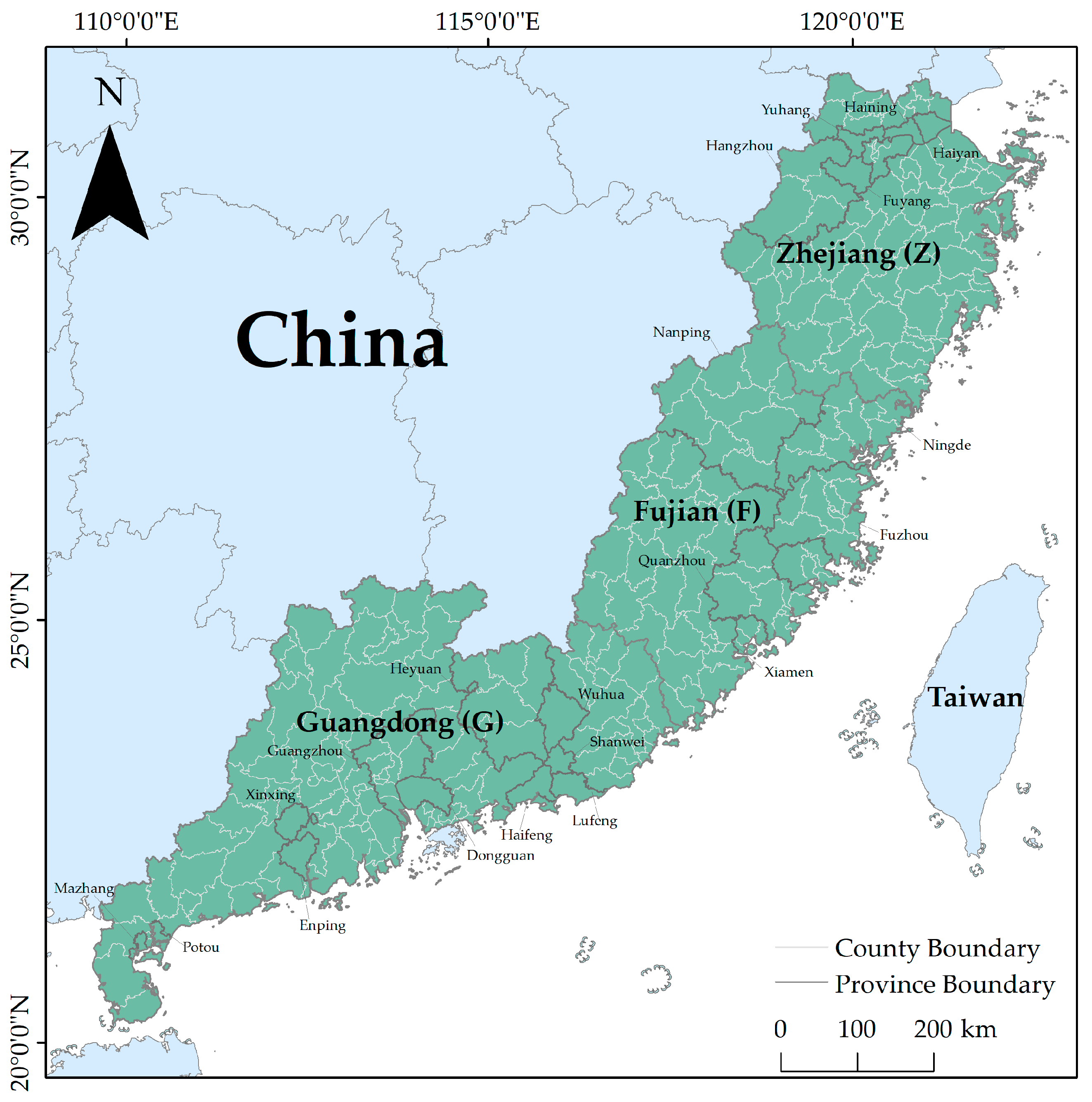
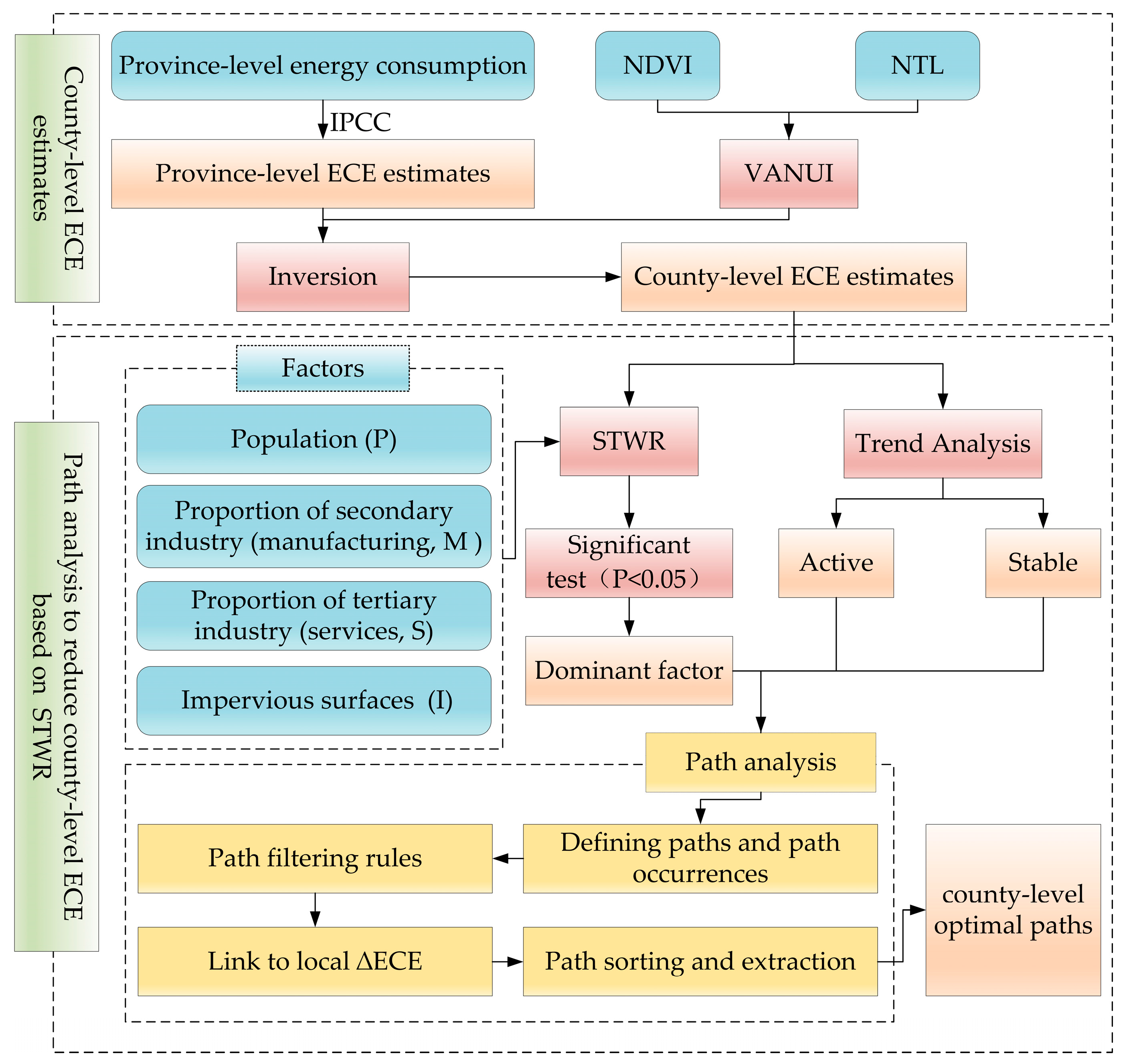
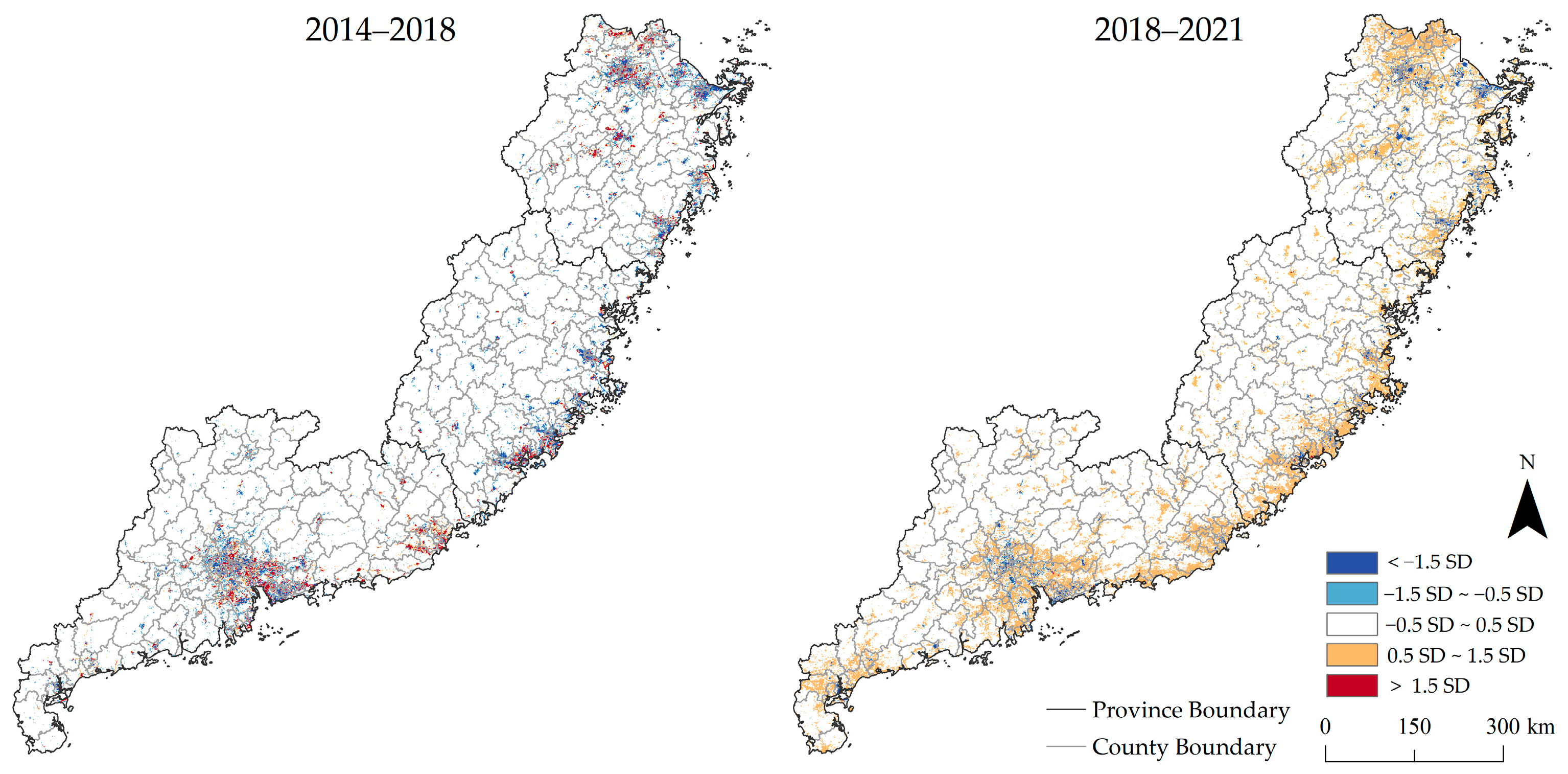

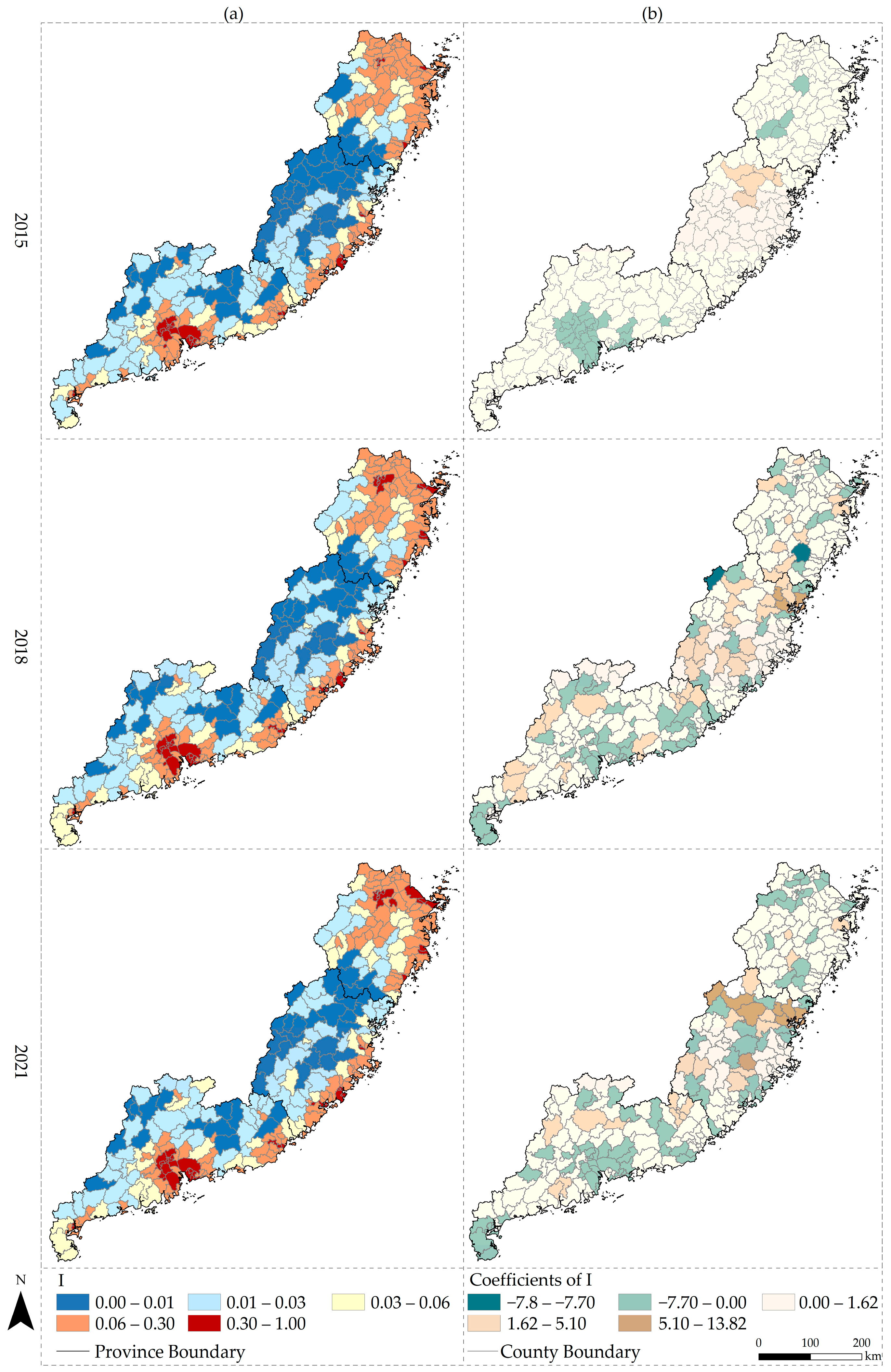

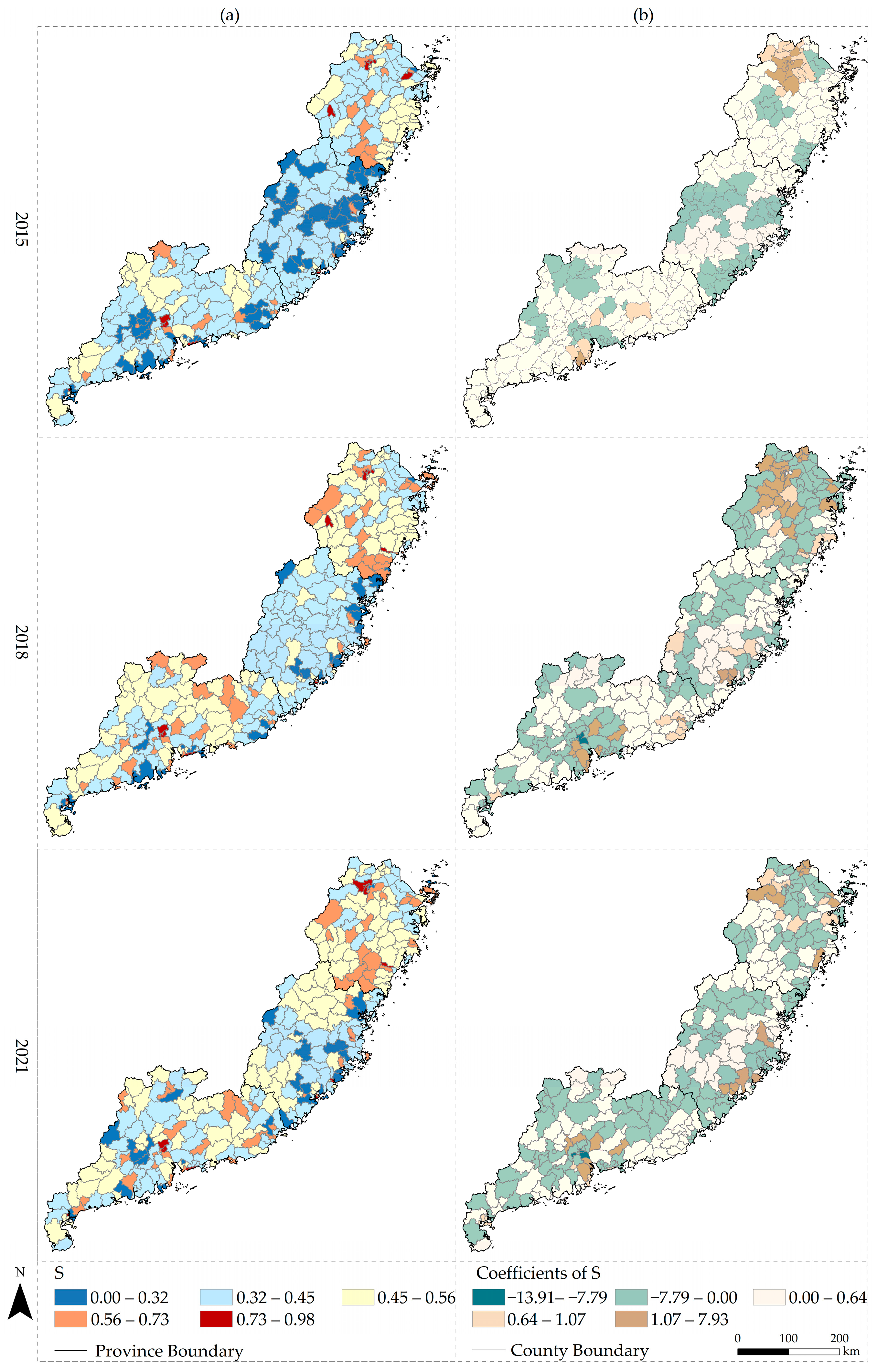


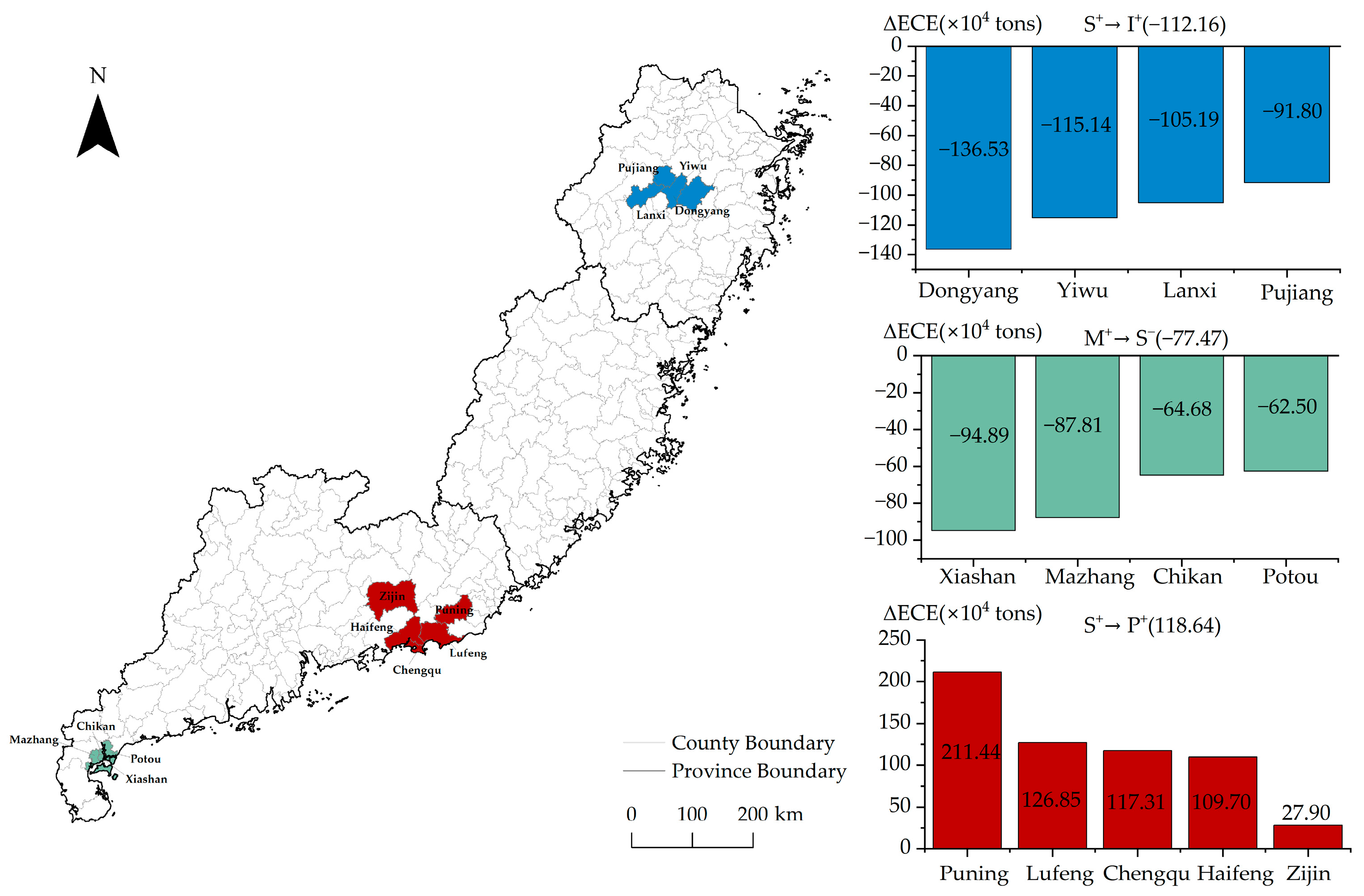
| Data | Source | Resolution |
|---|---|---|
| NTL remote sensing images | Earth Observation Group (https://eogdata.mines.edu/products/vnl/, accessed on 30 January 2025) | 500 m |
| Normalized Difference Vegetation Index (NDVI) | Resource and Environmental Science Data Platform (http://www.resdc.cn/, accessed on 30 January 2025) | 1000 m |
| Population (P) | LandScan dataset (https://landscan.ornl.gov/, accessed on 30 January 2025) | 1000 m |
| Proportion of secondary industry (manufacturing, M) | China Economic and Social Big Data Research Platform (https://data.cnki.net/, accessed on 30 January 2025) | County level |
| Proportion of tertiary industry (services, S) | ||
| Impervious surfaces (I) |
| Area | Average | 2014 | 2015 | 2016 | 2017 | 2018 | 2019 | 2020 | 2021 |
|---|---|---|---|---|---|---|---|---|---|
| Guangdong | 12.29 | −11.45 | −14.51 | −20.27 | −15.05 | 1.43 | 2.36 | 13.94 | 19.27 |
| Fujian | 7.91 | −17.75 | −13.12 | −8.19 | 7.16 | 2.74 | 1.12 | 5.85 | 7.32 |
| Zhejiang | 13.02 | 22.75 | 22.90 | 15.00 | 3.40 | 1.35 | −9.32 | −13.15 | −16.29 |
| Groups | Activate Period (2014–2018) | Stable Period (2018–2021) |
|---|---|---|
| <−1.5 SD | Slope < −0.067 | Slope < −0.070 |
| −1.5 SD~−0.5 SD | −0.067 ≤ Slope < −0.013 | −0.070 ≤ Slope < −0.033 |
| −0.5 SD~0.5 SD | −0.013 ≤ Slope < 0.041 | −0.033 ≤ Slope < 0.004 |
| 0.5 SD~1.5 SD | 0.041 ≤ Slope < 0.095 | 0.004 ≤ Slope < 0.041 |
| ≥1.5 SD | Slope ≥ 0.095 | Slope ≥ 0.041 |
| P | I | M | S | |
|---|---|---|---|---|
| VIF | 1.128 | 1.891 | 3.484 | 4.612 |
| Tolerance | 0.886 | 0.529 | 0.287 | 0.217 |
| Year | Model | R2 | AICc | SSE |
|---|---|---|---|---|
| 2014 | OLS | 0.775 | 412.289 | 67.177 |
| GWR | 0.926 | 248.566 | 22.235 | |
| STWR | 0.936 | 260.196 | 19.090 | |
| 2015 | OLS | 0.779 | 407.101 | 66.021 |
| GWR | 0.927 | 240.822 | 21.720 | |
| STWR | 0.957 | 61.409 | 12.777 | |
| 2016 | OLS | 0.788 | 395.476 | 63.504 |
| GWR | 0.928 | 239.112 | 21.555 | |
| STWR | 0.997 | −606.769 | 0.874 | |
| 2017 | OLS | 0.802 | 375.143 | 59.329 |
| GWR | 0.942 | 189.133 | 17.402 | |
| STWR | 0.994 | −388.742 | 1.684 | |
| 2018 | OLS | 0.799 | 378.736 | 60.046 |
| GWR | 0.934 | 211.395 | 19.689 | |
| STWR | 0.998 | −549.380 | 0.490 | |
| 2019 | OLS | 0.816 | 353.139 | 55.120 |
| GWR | 0.936 | 214.841 | 19.262 | |
| STWR | 0.998 | −398.609 | 0.670 | |
| 2020 | OLS | 0.822 | 343.044 | 53.290 |
| GWR | 0.942 | 181.151 | 17.223 | |
| STWR | 0.997 | −531.810 | 0.927 | |
| 2021 | OLS | 0.819 | 347.381 | 54.068 |
| GWR | 0.938 | 201.057 | 18.575 | |
| STWR | 0.997 | −574.186 | 0.921 |
| Area | Path | Tons) | (%) | (%) | |
|---|---|---|---|---|---|
| Enping | P+ → I+ | 137.0 → 157.4 (20.4) | 515,765 → 525,587 (1.9%) | 29.9% → 27.6% (−7.7%) | 59.7% → 56.8% (−4.9%) |
| Xinxing | P+ → I+ | 115.1 → 148.7 (33.6) | 447,996 → 452,660 (1.0%) | 30.3% → 34.8% (14.9%) | 48.1% → 40.6% (−15.6%) |
| Lufeng | P+ → P+ | 345.0 → 465.7(120.7) | 1,407,137 → 1,415,325 (0.1%) | 42.9% → 40.6% (−5.4%) | 37.0% → 40.8% (10.3%) |
Disclaimer/Publisher’s Note: The statements, opinions and data contained in all publications are solely those of the individual author(s) and contributor(s) and not of MDPI and/or the editor(s). MDPI and/or the editor(s) disclaim responsibility for any injury to people or property resulting from any ideas, methods, instructions or products referred to in the content. |
© 2025 by the authors. Licensee MDPI, Basel, Switzerland. This article is an open access article distributed under the terms and conditions of the Creative Commons Attribution (CC BY) license (https://creativecommons.org/licenses/by/4.0/).
Share and Cite
Lai, Y.; Fei, T.; Wang, C.; Xu, X.; Zhuang, X.; Que, X.; Zhang, Y.; Yuan, W.; Yang, H.; Hong, Y. Energy Carbon Emission Reduction Based on Spatiotemporal Heterogeneity: A County-Level Empirical Analysis in Guangdong, Fujian, and Zhejiang. Sustainability 2025, 17, 3218. https://doi.org/10.3390/su17073218
Lai Y, Fei T, Wang C, Xu X, Zhuang X, Que X, Zhang Y, Yuan W, Yang H, Hong Y. Energy Carbon Emission Reduction Based on Spatiotemporal Heterogeneity: A County-Level Empirical Analysis in Guangdong, Fujian, and Zhejiang. Sustainability. 2025; 17(7):3218. https://doi.org/10.3390/su17073218
Chicago/Turabian StyleLai, Yuting, Tingting Fei, Chen Wang, Xiaoying Xu, Xinhan Zhuang, Xiang Que, Yanjiao Zhang, Wenli Yuan, Haohao Yang, and Yu Hong. 2025. "Energy Carbon Emission Reduction Based on Spatiotemporal Heterogeneity: A County-Level Empirical Analysis in Guangdong, Fujian, and Zhejiang" Sustainability 17, no. 7: 3218. https://doi.org/10.3390/su17073218
APA StyleLai, Y., Fei, T., Wang, C., Xu, X., Zhuang, X., Que, X., Zhang, Y., Yuan, W., Yang, H., & Hong, Y. (2025). Energy Carbon Emission Reduction Based on Spatiotemporal Heterogeneity: A County-Level Empirical Analysis in Guangdong, Fujian, and Zhejiang. Sustainability, 17(7), 3218. https://doi.org/10.3390/su17073218







